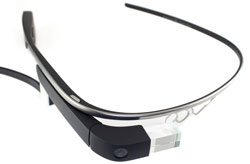
The sharing of information is an everyday occurrence - whether you are uploading a video to YouTube, posting photos of a recent holiday on Facebook, or emailing important documents to a manager.
Google is about to introduce Google Glass to the general public, with the hopes of simplifying the exchange of people's ever-growing database of life experiences and offering them a glimpse into the future of wearable technology.
Yes, it's great for social sharing, but the more ambitious avenue to pursue is the business world, with its multitude of possible applications. Information Technology is one of the benefactors in this arena and speculating on how Google Glass can impact this billion rand industry is both exciting and daunting.
Let's look at the ways in which the Glass technology can be applied to the business world in its current form, and how it could be implemented in the realms of the software development industry.
The latest incarnation of Google's invention is simply called Google Glass 2, an updated version of its Explorer Edition heads-up display, with an almost identical form factor. It includes new accessories, enhancements to the software, as well as new and improved applications.
The device itself comprises:
• A titanium headband with a cube-shaped glass prism, which projects images onto the wearer's field of vision.
• A rather bulky battery on the right-hand side.
• A camera lens at the front for taking photos and recording video.
• A few physical buttons.
• A touch pad that allows users to control the device by swiping through a timeline-like interface displayed on the screen.
• A micro USB port for charging and connecting the device to a computer. The capabilities of the device include:
• Uploading photos and HD video captured with Glass directly to the Internet.
• Displaying various pieces of information (such as weather updates) right in front of the wearer's field of vision.
• Reacting to voice commands for web searches.
• Sending text messages.
• Translating spoken phrases or words identified by the camera.
Head gestures also provide an enhanced experience beyond the touch of a physical button, as a 30° upward glance wakes up the device.
Even though Google's wearable tech marvel will have dozens of social applications for the general population, the more pertinent question is how it can be applied in the corporate world, and more specifically the software development industry.
A number of avenues for real-world applications covering various occupations have already been identified. Some of these include the construction, health care, education, and law enforcement sectors, but so far very little mention has been made of information technology integration.
Ways in which Glass can assist individuals in the business world can be illustrated by the following scenario:
An executive's flight information for the next morning is beamed right in front of him courtesy of the Google Now application. When he leaves the airport, he follows directions read out loud to him to get to the car rental agency. Once it appears within sight, the company's logo is highlighted for him. All he needs to do is to follow the GPS directions that appear in-view. Later, when waiting in the lobby of an important client, he can read his emails and peruse financial statistics without having to even take out his smartphone.
Expanding on these avenues of application for computer software development in the work force yields a couple of interesting possibilities:

Collaborating with fellow employees to solve a business or coding relating problem could be the tap of a button on your Glass away. On their screens, collaborators on a project could see what the developer is seeing via the device's integrated camera, assist with coding challenges, or give insight into performance-tuning by verifying real-time figures as the wearer of Glass views it.
Error searching and reporting could also be simplified. Glass can search online forums for possible causes and provide potential fixes to an error message that the integrated software identifies via the camera. The search results can be followed up on immediately or a list of website links emailed to the developer for later perusal. Logging an issue to a company's help desk could also be as easy as linking the site to a gesture, such as blinking twice with your right eye. The identified error message and a screenshot of captured system information can then be uploaded (together with pre-populated personal information) to the site within seconds.
Identifying potential new clients or competitors also takes on a new dimension - while the wearer drives past an advertisement board or reads the business section of a newspaper, Glass can identify and highlight companies as potential targets for new business. This identification would be based on certain predefined settings, such as the kind of industry the clients operate in, as well as their location in relation to the wearer's company.
Threats to the firm can also be recognised in this way. A compiled profile of your business (which showcases its strengths and weaknesses) will be evaluated against the competition, and suggestions on improving the company to successfully compete with rivals can be shown to the wearer.
As with any new piece of technology, the real challenge will be to convince existing clients of the potential that Glass has and what it can offer them, over and above whatever existing infrastructure in which they have already invested.
There are a number of Glass characteristics that might benefit clients beyond the capabilities of current smart phones and other such devices:
• Its prompt response to user input via spoken words and eye movements or blinks, which might prove useful to personal assistants and call centre agents.
• The benefit of not having to use your hands when operating the device, leaving you free to engage in other multi-tasking operations.
• Its non-intrusive way of interacting with employees and other persons of interest when needing to record meetings or conversations.
In the end it comes down to whether the client would be willing to fork out the necessary funds to invest in this new Google venture and if the invested capital would benefit the client in the long run. As Glass becomes more integrated into society (and businesses in particular) we might see this move becoming more obvious to a client.
Even though the latest iteration of Google Glass is still a prototype, we cannot help but be excited for the possibilities it contains. Introducing a new piece of technology to the world is never an easy feat, but considering the reputation that Google has built up over the years and the new generation of computing technology presently available, it will only be a matter of time before people become curious enough to want to own Glass and experiment with its capabilities for themselves.
The focus of Google Glass may seem - for the time being - to rest squarely on entertainment, but a multitude of opportunities exist within the business world. The software development field especially could benefit greatly from innovative and time-saving implementations. These would quite possibly change the ways many professionals go about their daily work and positively impact their clients in the process. One thing is sure though, the future of Google Glass is bright and the possibilities for implementing it are thrilling.
References
En.wikipedia.org
businessinsider.com
Input from a fellow colleague, Nemanja Stabic.